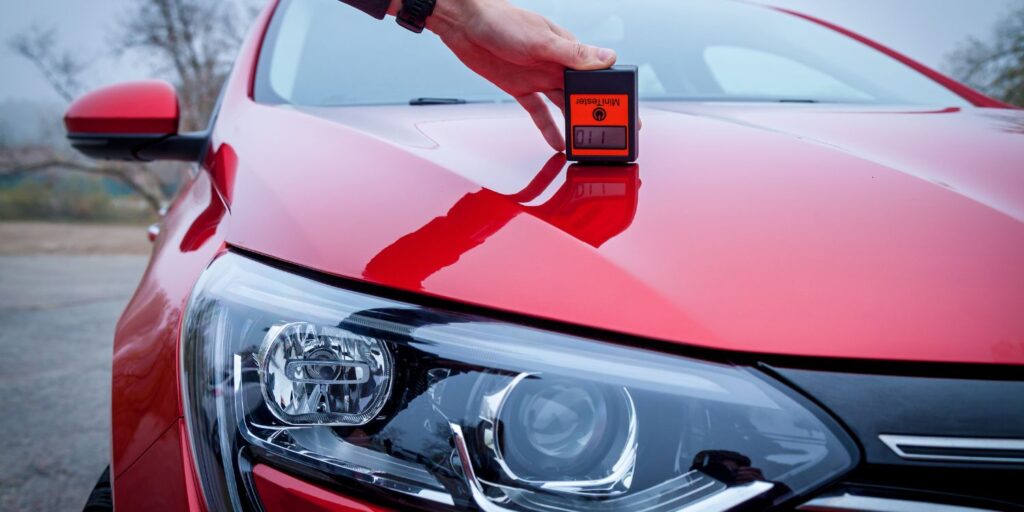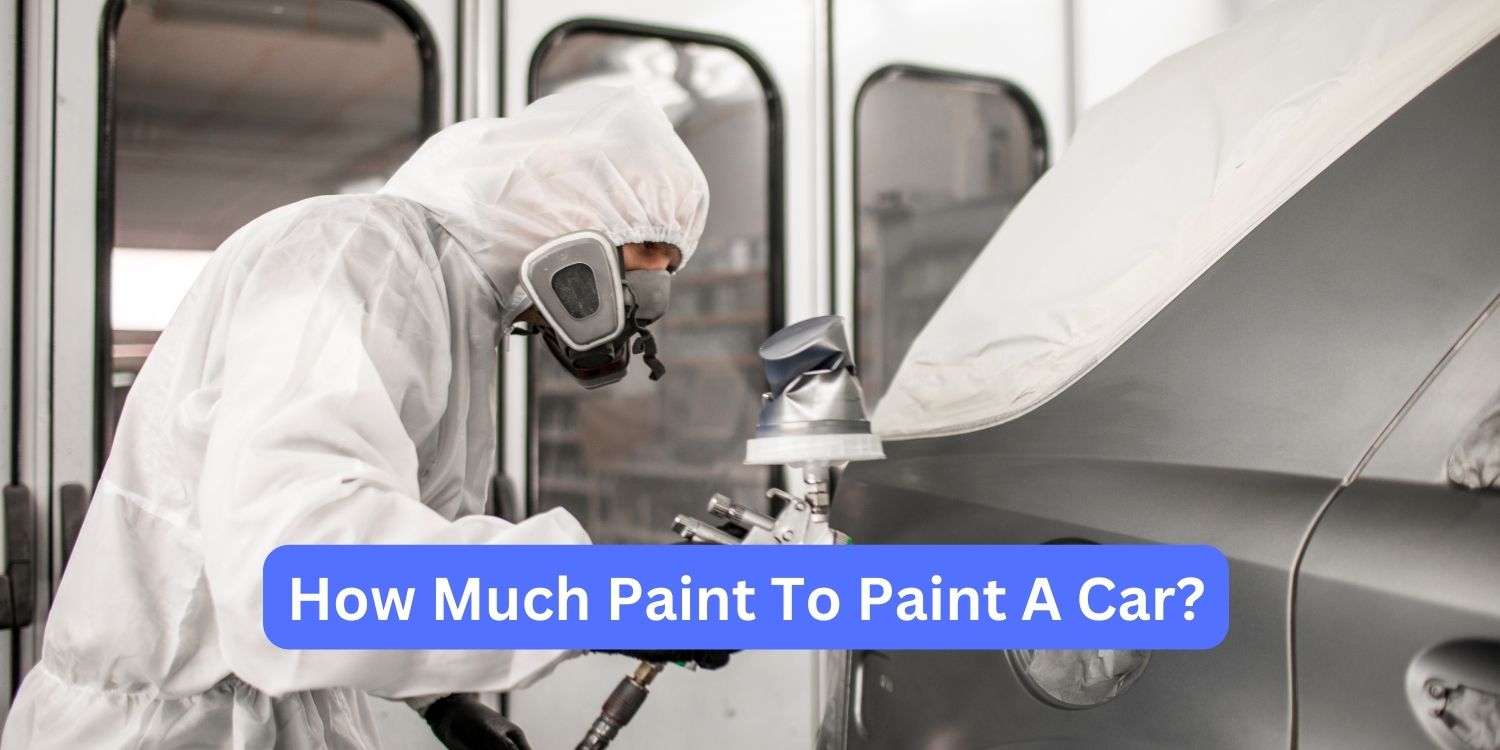If you plan to decorate your car’s appearance at a value-effective rate, painting it is one of the best and least expensive options.
Before rushing to the local store or browsing online for car paint, it’s advisable to estimate how much paint you’ll need for your car/vehicle.
This clarifies the question of “How much paint to paint a car?” and helps save money on the overall painting project.
Estimating Paint Quantity for Cars/vehicles – A Detailed Guide
Planning a new paint job for your car can be tricky because there’s much to consider! This guide will help you figure out how much paint you’ll need.
We’ll cover things like the size and shape of your car, the type of paint you choose, how you’ll apply it, and how much area each can of paint will cover.
Read more about The Benefits of Paint Protection and Window Tinting.
1) The Body Art Blueprint: Measuring Your Car for a Perfect Paint Job
Before figuring out how much paint is needed to make a car look great, we need to understand how the car is shaped and sized. It’s kind of like how mapmakers carefully draw borders around different areas.
We must look closely at every part of the car – from the big parts like the hood and trunk to the small corners and edges. It’s like going on an adventure to explore all the hidden parts of the car, inside and out.
This exploration is important before accurately estimating how much paint we’ll need.

2) Priming – Building the Foundation for Vibrant Car Paint
Before the colourful magic of painting begins, there’s an important step called priming. Think of it like the foundation of a house – it’s essential for making sure the paint sticks properly and looks great.
Primers are like the secret sauce transforming a plain car into a shiny masterpiece. By carefully applying one or two coats of primer, we prepare the car for its vibrant makeover, ensuring the paint looks amazing and lasts a long time.
3) Understanding How Much Paint Your Car Needs:
In figuring out how much paint you need to paint a car, figuring out the base coat is like solving a tricky puzzle. Basecoats, with their mix of colours and thickness, challenge you to understand how much area they can cover.
It’s like dancing delicately between making sure the paint is thick enough but not too thick and using two or three layers to make the car look consistently colourful and beautiful.
4) Unveiling the Mysteries of Paint Coverage:
How much area a gallon of paint can cover is crucial in paint types. Some paints can cover a lot – up to 350-400 square feet per gallon, giving your car a beautiful finish.
But others aren’t as good and cover less area. It’s like a magical spell, where the right paint transforms your vehicle, making it shiny and vibrant.
5) Exploring the Intricacies of Paint Types
Amidst the vast array of paint types available, the interaction between solvent-based and water-based options creates a fascinating mix of possibilities.
Solvent-based paints, with their potent fumes and mysterious chemical components, give cars a captivating shine, covering surfaces more efficiently than water-based alternatives.
On the other hand, water-based paints are environmentally friendly, though they may require more coats for full coverage. This presents a choice for painters to make, balancing the benefits of each type depending on their needs.
It’s like navigating a maze of paint options, with artists carefully selecting the best path between solvent and water-based realms to achieve their desired results.
6) The Refined Coordination of Application
Setting out on the colourful journey of making cars look beautiful requires careful application, where the amount of paint mixes with the right techniques.
It’s like conducting a beautiful orchestra with sprays and brushes, each stroke showing skill and care as the car’s surface becomes shiny under the artist’s touch.
The process is like a graceful dance, with each layer of paint adding to the car’s overall beauty and showcasing the painter’s talent and the stunning change in the car’s appearance.
7) Navigating Paint Estimation- Expert Advice for Success
In figuring out how much paint you need, getting advice from experienced pros is like finding a guiding light in a dark maze.
With their knowledgeable staff, places like car shops and paint stores offer valuable insights that can help beginners navigate the confusion.
It’s like going on a helpful journey where you learn all about paint estimation from the experts, and your car ends up looking amazing thanks to their advice and expertise.
8) Unlocking the Secrets of Car Painting – A Journey of Color and Creativity
In car painting, figuring out how much paint you need for a fantastic finish is like solving a tricky puzzle. It’s a mix of complicated factors and artistic skills coming together in a beautiful dance of colours.
As you navigate the process of estimating paint, it’s like embarking on an exciting adventure.
You’re exploring how different colours and techniques work together, creating a stunning masterpiece on your car’s surface with skillful strokes.
FAQS
Some frequently asked questions about Painting a car are :
How Do I Estimate The Amount Of Paint Needed For My Car?
Estimating paint quantity for your car involves considering factors like the size and shape of your vehicle, the type of paint chosen, and the application method.
By carefully measuring and calculating these variables, you can determine the appropriate amount of paint required for your project.
Why Is Priming Necessary Before Painting A Car?
Priming serves as the foundation for vibrant car paint, ensuring proper adhesion and longevity of the paint job.
Like laying a foundation for a house, priming prepares the car’s surface, enhancing the paint’s durability and finish.
How many coats of paint are needed for a car?
Determining the number of paint coats depends on the type of paint used, desired finish, and coverage area.
Generally, applying two to three coats of paint ensures a consistent and beautiful finish, balancing thickness and coverage.
What factors affect paint coverage for a car?
Several factors influence paint coverage, including the type and quality of paint, surface preparation, and application method.
Understanding these variables helps in optimizing paint usage and achieving desired results.
What are the differences between solvent-based and water-based paints for cars?
Solvent-based paints offer superior coverage and durability but emit potent fumes and contain mysterious chemical components.
On the other hand, water-based paints are environmentally friendly but may require more coats for full coverage.
Choosing between them involves balancing benefits and considerations based on individual needs and preferences.
Conclusion
In automotive rejuvenation, a well-executed paint job is the crowning glory, transforming a vehicle from mundane to magnificent.
As you endeavor to revitalize your car’s appearance, estimating the quantity of paint required emerges as a pivotal step, ensuring both a seamless process and a stunning outcome.
Through meticulous measurement, thoughtful selection of paint type, and skilled application techniques, you embark on a journey of artistic expression and practicality.
Each stroke of the brush or spray can become a testament to your creativity and attention to detail.
Seeking guidance from industry experts and leveraging their insights can elevate your painting project to new heights, providing valuable advice on paint selection, coverage estimation, and application methods.
Their expertise serves as a compass, guiding you through the complexities of paint estimation with confidence and clarity.
Ultimately, as you unlock the secrets of car painting and breathe new life into your vehicle’s exterior, you enhance its aesthetic appeal and imbue it with personality and character.
Your car becomes a canvas, reflecting your unique style and vision as you navigate the open road.
So, whether you’re embarking on a DIY painting project or enlisting the help of professionals, remember that estimating paint quantities is not just about numbers; it’s about realizing the full potential of your automotive masterpiece.
With careful planning, attention to detail, and a touch of creativity, you can achieve a paint job that truly stands out and leaves a lasting impression.



